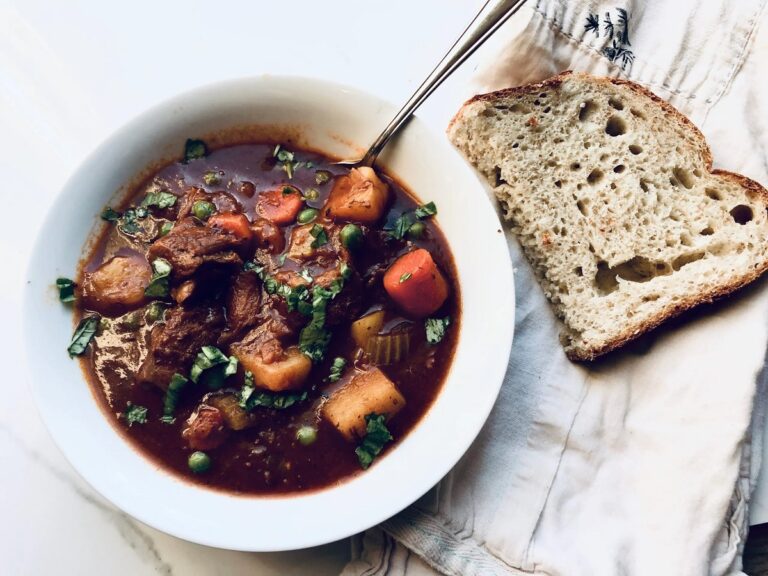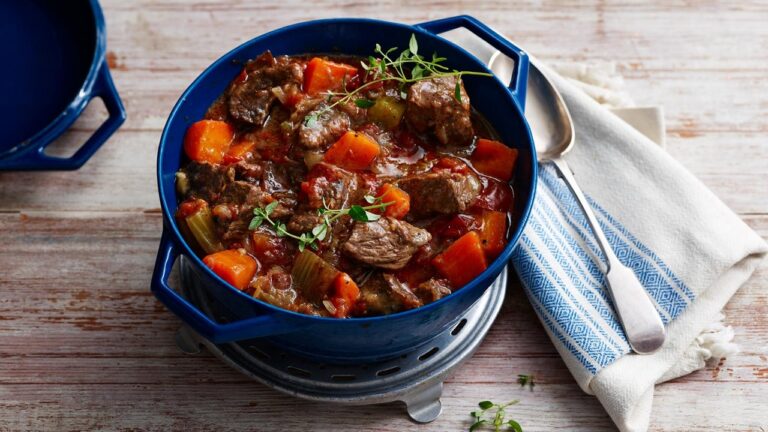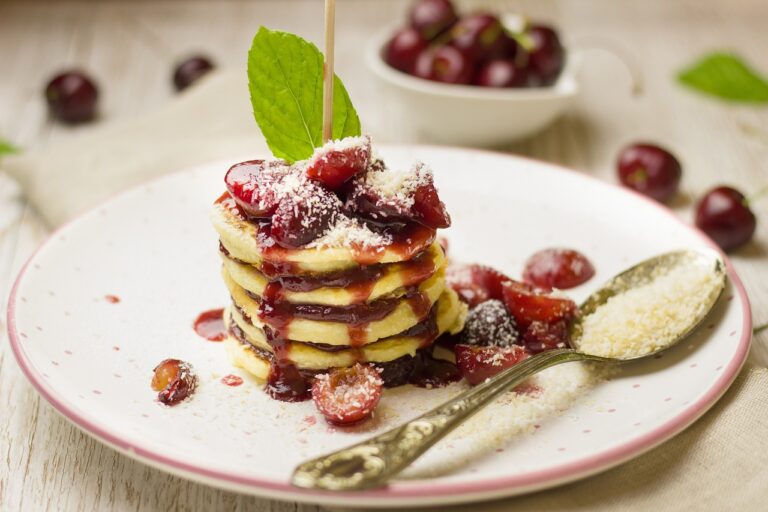Classic Chewy Chocolate Chip Cookies Recipe
Chocolate chip cookies are a timeless favorite, beloved for their chewy texture and rich chocolate flavor. This recipe, inspired by John Kanell from Preppy Kitchen, ensures that you achieve the perfect cookie every time. Follow these detailed steps to create delicious, homemade chocolate chip cookies that will impress your family and friends.
Ingredients
- All-purpose flour: 2 ¼ cups (270 grams)
- Baking soda: ¾ teaspoon
- Salt: ¾ teaspoon
- Unsalted butter: 1 cup (226 grams), room temperature
- Granulated sugar: ¾ cup (150 grams)
- Light brown sugar: ¾ cup (165 grams)
- Egg: 1 large, room temperature
- Vanilla extract: 1 tablespoon (15 mL)
- Chocolate chips: 2 cups (about 340 grams) or your choice of chopped chocolate bars
Instructions to Make Chocolate Chip Cookies At Home
Step 1: Prepare the Dry Ingredients
- In a medium bowl, whisk together the all-purpose flour, baking soda, and salt. This step is crucial to ensure that the baking soda and salt are evenly distributed throughout the flour mixture.
Step 2: Cream the Butter and Sugars
- In the bowl of a stand mixer fitted with a paddle attachment, add the room temperature butter.
- Beat the butter on medium-low speed for about a minute until it is slightly creamy.
- Gradually add the granulated sugar and light brown sugar to the bowl. Continue mixing on medium-low speed until the mixture is very light and fluffy, approximately five minutes.
Step 3: Incorporate Egg and Vanilla
- Crack the egg into the butter-sugar mixture and mix until fully incorporated.
- Add the vanilla extract and mix again. Make sure to scrape down the sides of the bowl to ensure everything is well combined.
Step 4: Combine Dry and Wet Ingredients
- Gradually add the flour mixture to the wet ingredients, mixing on low speed until just combined. It’s okay if some flour remains visible at this stage.
- Fold in the chocolate chips using a spatula or a wooden spoon, ensuring they are evenly distributed throughout the dough.
Step 5: Chill the Dough
- Cover the bowl with plastic wrap or transfer the dough to an airtight container.
- Chill in the refrigerator for at least one hour; longer chilling times enhance flavor and texture.
Step 6: Preheat Oven and Prepare Baking Sheets
- Preheat your oven to 375°F (190°C).
- Line baking sheets with parchment paper or silicone baking mats.
Step 7: Scoop and Shape Cookies
- Using a cookie scoop or tablespoon, portion out about 1½ tablespoons of dough for each cookie.
- Roll each portion into a ball and place it on the prepared baking sheets, leaving enough space between each cookie to allow for spreading.
- Optionally, place a few extra chocolate chips on top of each cookie for visual appeal.
Step 8: Bake
- Bake in the preheated oven for 10 to 12 minutes or until the edges are golden brown but the centers still look slightly underbaked.
- Remove from oven and let cool on baking sheets for a few minutes before transferring them to wire racks to cool completely.
Tips for Making Sure Cookies Don’t Spread Too Much in the Oven
To prevent cookies from spreading excessively during baking, there are several effective strategies you can employ. First, chilling the dough is crucial; refrigerate your cookie dough for at least 30 minutes to an hour. This process solidifies the fat, slowing down its melting and helping the cookies maintain their shape.
Additionally, lining your baking sheets with parchment paper or silicone mats instead of greasing them can make a significant difference, as greased pans often lead to excessive spreading. It’s also important to ensure that your baking sheets are completely cool before placing new dough on them; a hot pan can warm the dough too quickly, causing it to spread before entering the oven.
Accurate measurement of ingredients is another key factor; using a kitchen scale for precise measurements, particularly with flour, can help avoid issues where too much or too little flour affects spreading.
Lastly, always check that your oven is properly preheated; an oven that is too cool can lead to cookies spreading too much as the fat melts before the cookie sets.
Can I Use a Different Type of Sugar Instead of Light Brown Sugar?
Yes, you can certainly substitute light brown sugar with various other types of sugar, each bringing its own unique qualities to your cookies. Granulated sugar is a common alternative that will yield slightly different texture and flavor but still results in delicious cookies.
Dark brown sugar is another option; it has a higher molasses content than light brown sugar, imparting a richer flavor profile to your baked goods. For those seeking a healthier alternative, coconut sugar can be used as well; it provides similar sweetness while offering a slight caramel flavor.
However, it’s important to remember that substituting sugars may slightly alter the final texture and taste of your cookies, so some experimentation might be necessary to achieve your desired results.
How Can I Make These Cookies Less Sweet?
To reduce the sweetness of your chocolate chip cookies without compromising their overall appeal, consider a few simple adjustments. One effective method is to decrease the sugar amount by about 10% by weight; this small reduction can help balance sweetness while maintaining texture.
Another option is to use dark chocolate chips instead of semi-sweet or milk chocolate chips, as dark chocolate contains less sugar and offers a more intense flavor that can offset sweetness. Additionally, adding more flour can help absorb some of the sweetness and contribute to a thicker cookie.
Incorporating chopped nuts or oats is another great way to provide texture and flavor that balances out sweetness effectively.
What’s the Best Way to Store Leftover Chocolate Chip Cookies?
To store leftover chocolate chip cookies effectively and keep them fresh for as long as possible, start by placing them in an airtight container at room temperature. This method helps maintain their softness and prevents them from becoming stale.
If you need to stack cookies within the container, be sure to separate layers with parchment paper to prevent sticking. For longer storage options—up to a week—you can refrigerate them in an airtight container.
If you’re looking for extended storage solutions, freezing is ideal: place cookies in a single layer on a baking sheet until solid, then transfer them to a freezer-safe bag or container. Frozen cookies can last up to three months while retaining their quality.
Can I Substitute All-Purpose Flour with Another Type of Flour?
Absolutely! You can substitute all-purpose flour with various alternatives depending on your dietary needs or preferences. Whole wheat flour is one option that adds more fiber and nutrients but may result in denser cookies; you might need to adjust the liquid content accordingly.
Almond flour serves as a gluten-free alternative that provides a nutty flavor but may require additional binding agents like eggs for optimal texture. Oat flour is another gluten-free choice made from ground oats; it adds a mild flavor but can affect texture and moisture levels in your baked goods.
When experimenting with flour substitutions, it’s often best to start with a blend of all-purpose flour and your chosen alternative to maintain texture while exploring new flavors.
People Also Asked
How long should the cookie dough be chilled?
The cookie dough should be chilled for at least one hour, but chilling it longer enhances the flavor and texture of the cookies.
At what temperature should the cookies be baked?
The cookies should be baked in an oven preheated to 375°F (190°C) for about 10 to 12 minutes, or until the edges are golden and set.
Why is it important to cream the butter and sugars properly?
Properly creaming the butter and sugars until light and fluffy ensures a good texture in the cookies. This process incorporates air, which contributes to a chewy center and prevents the cookies from becoming flat or burnt.
What can be done if the cookie dough is too hard to scoop after chilling?
If the chilled cookie dough is too hard due to the butter, you can roll it gently in your hands to shape it before placing it on the baking sheet.
Enjoy Your Cookies!
These chewy chocolate chip cookies are best enjoyed fresh out of the oven but can also be stored in an airtight container for several days. The combination of brown sugar with butter creates a rich flavor profile that pairs perfectly with gooey chocolate chips.
Whether you’re baking for a special occasion or just indulging in a sweet treat, this classic recipe is sure to satisfy your cravings!






